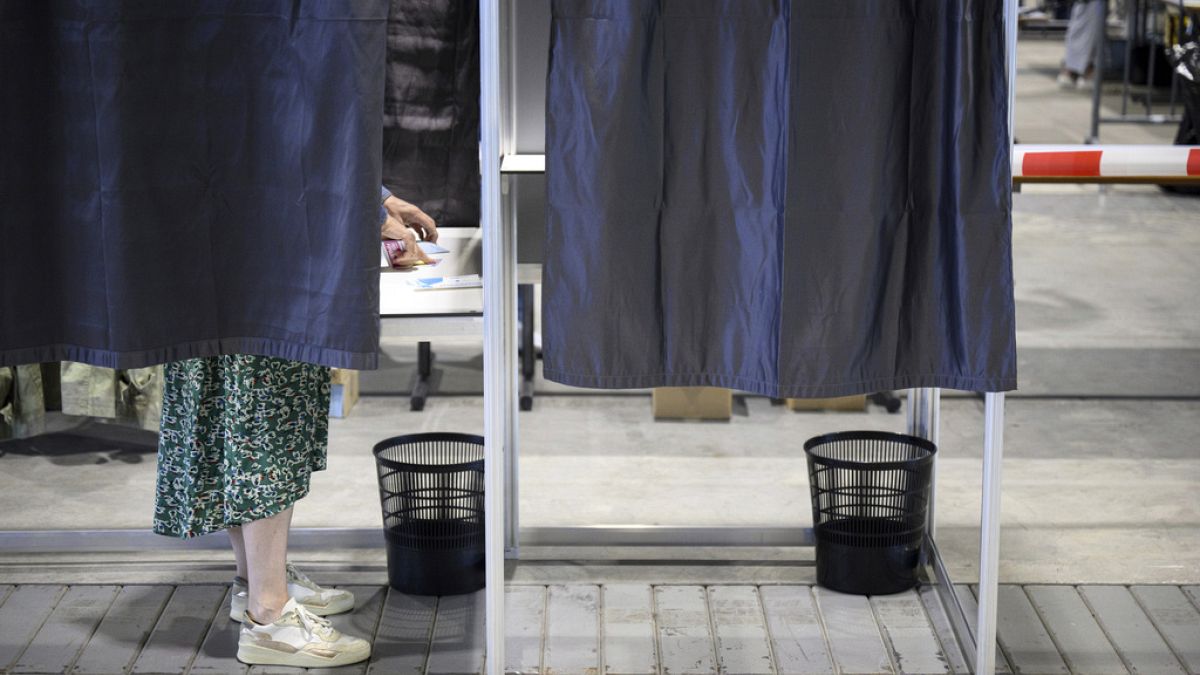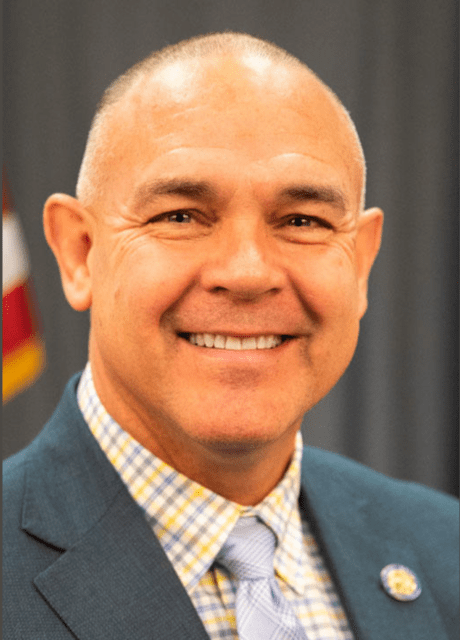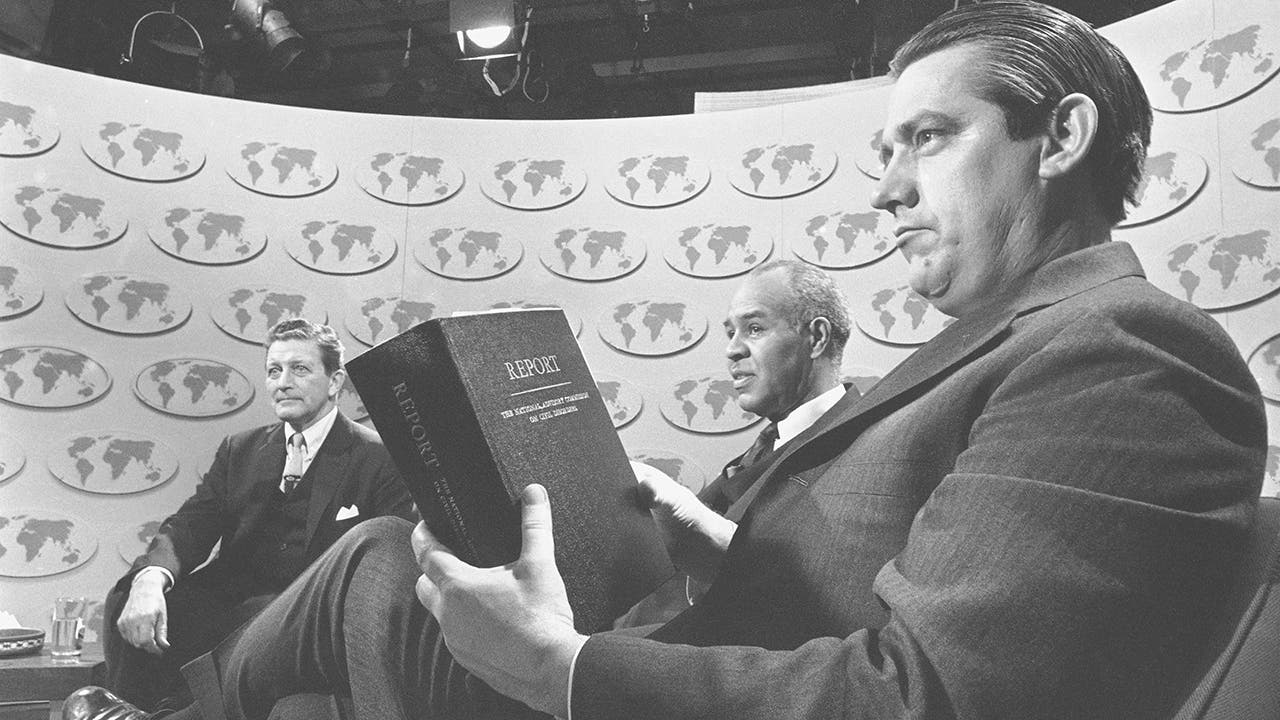World
Odds for more sports betting expansion could fade after rapid growth to 38 states

JEFFERSON CITY, Mo. (AP) — At his suburban St. Louis home, Brett Koenig can pull out his smartphone and open a sports betting app. But he can’t place a bet. He is blocked by a pop-up message noting he is not in a legal location.
Missouri is one of a dozen states where sports wagering remains illegal more than five years after the U.S. Supreme Court cleared the way for states to adopt it.
“It just seems silly that everyone else can do it and we can’t,” said Koenig, who has launched a social media campaign called “Let MO Play” to rally support for legal sports betting in his home state.
Other states have reaped a total of over $4 billion of taxes from more than $280 billion wagered on sports since 2018. Vermont will become the latest to accept sports bets, starting Jan. 11, But the odds for expansion to additional states appear iffy in 2024 because of political resistance and the sometimes competing financial interests of existing gambling operators.
“The handful of states yet to legalize are last for a reason: They all have multiple obstacles,” said Becca Giden, policy director at Eilers & Krejcik Gaming, a California-based consulting firm.
After a “whirlwind” of expansion, the playing field for further sports betting has narrowed to a group of states where various stakeholders all “want to kind of maximize what they get out of the legalization framework,” said Chris Cylke, senior vice president of government relations at the American Gaming Association, which represents the industry. “So that can create some friction.”
The states where sports betting remains illegal are Alabama, Alaska, California, Georgia, Hawaii, Idaho, Minnesota, Missouri, Oklahoma, South Carolina, Texas and Utah.
California and Texas, the nation’s two most populous states, would be the biggest prizes for sports bettors. But neither appear particularly likely to adopt it in 2024.
Voters in California last year overwhelmingly defeated two rival sports betting initiatives following a record $463 million raised by supporters and opponents. The advertising barrage was fueled by divisions among online gaming companies, tribal casinos and horse tracks. Those tensions have continued, with Native American tribes objecting to a new sports betting initiative that is seeking signatures to appear on the 2024 ballot.
The proposed sale of the Dallas Mavericks basketball team to a politically active family that runs the Las Vegas Sands casino company has raised speculation of a bigger push for legal sports betting in Texas. But the state Legislature is not in regular session in 2024, and Texas has no means of placing citizen initiatives on the ballot.
Neighboring Oklahoma already has scores of casinos run by tribes. Republican Gov. Kevin Stitt announced a plan in November to allow in-person sports betting at tribal casinos and online sports wagering through platforms licensed by the state. But his plan doesn’t appear to have support from tribes, with whom Stitt has been feuding.
Minnesota is perhaps the next likeliest state to authorize sports betting, but that probably would require a bipartisan vote in the Senate, where Democrats hold a slim one-seat advantage over Republicans. Lawmakers this past year struggled to resolve differences between tribal casinos, which want exclusive rights over online and in-person sports betting, and horse racing tracks, which also want a greater share of the gambling market. But they will try again.
“From the perspective of the tribes, the moment is now, and they’d like to see it done this year,” said Democratic state Sen. Matt Klein, a sponsor of sports betting legislation.
Efforts to legalize sports betting in Missouri have repeatedly stalled in the state Senate, where Republican Sen. Denny Hoskins insists it must be paired with the regulation of legally questionable slot-machine-style video games that have popped up in convenience stores and truck stops. Casinos oppose that.
Online sports wagering companies, casinos, professional sports teams and video gaming terminal interests have combined to hire about 80 lobbyists in Missouri.
The St. Louis Cardinals also are leading a coalition of the state’s professional sports teams proposing an initiative petition to put sports betting on the November ballot. But Senate President Pro Tem Caleb Rowden doubts the prospects of both the initiative petition and legislation, bemoaning that Missouri may “lose out on probably some fairly significant economic activity.”
Data suggests Missourians are interested in sports betting. From mid-June to mid-December, the technology firm GeoComply Solutions processed over 13.5 million location checks from 280,000 devices located in Missouri attempting to access mobile sports betting sites. About 48% were trying to use sportsbooks in Kansas, and 40% in Illinois. They were blocked from doing so.
When Koenig wants to bet on sports, he drives 45 minutes from his Missouri home to Illinois. He is not alone.
GeoComply processed 42,000 location checks from 1,900 online sports betting accounts that traveled from Missouri to an Illinois border town in the past six months. When the Kansas City Chiefs hosted the Buffalo Bills on Dec. 10, GeoComply tallied 786 location checks from 570 sportsbook accounts traveling from Missouri border towns into Kansas.
“It’s very easy for people to cross over, place their bets and then return to their home and watch the game,” GeoComply spokesman John Pappas said. “We see this thousands of times a day, a week, in any given state where it’s not legal.”
In Georgia, Republican Gov. Brian Kemp has expressed an openness to legalizing sports betting. But the effort stalled this past year when the Senate rejected a proposed constitutional amendment that would have let voters decide the issue. The debate is complex because proponents of casinos and horse racing want to leverage sports wagering to also legalize those forms of gambling.
Though still a toss-up, Georgia may be the most realistic candidate to authorize sports betting in 2024, Giden said. She expects a well-funded lobbying effort from the likes of online betting operators and sports teams.
To legally bet on sports in Alabama also would require a constitutional amendment approved by voters. In the Legislature, sports wagering proposals have become intertwined with broader efforts to expand gambling beyond the current tribal casinos, dog racing tracks and charitable bingo operators. None have been successful yet.
Republican state Sen. Greg Albritton said some lawmakers are working on new gambling legislation that would include casinos, a lottery and sports betting.
“Whatever happens, if I have my way, this issue will be debated this year,” he said.
___
Associated Press writer Kim Chandler contributed from Montgomery, Alabama.

World
Cinematography Work at Camerimage Festival ‘Radically Different,’ Jury Members Say

Jurors at the EnergaCamerimage cinematography fest say the Golden Frog main competition films have been remarkably varied and inspiring in the event’s 32nd edition.
The 12 competing films “were radically different from each other,” said “Barbie” and “Killers of the Flower Moon” cinematographer Rodrigo Prieto, whose directorial debut, “Pedro Paramo,” is also screening at the fest. “I enjoyed that.”
The varied styles, approaches and storytellers, he added, defied easy categorization. “Happily, I didn’t notice trends, which I have noticed sometimes in the past in some festivals.”
Juror Anthony Dod Mantle, who won Golden Frogs in 2008 for his lensing of “Slumdog Millionaire” and in 2016 for “Snowden,” said, “I’ve been to this festival before and the overall collection of films and categories, I felt, was even wider. I feel slight absence of certain films from other ethnic backgrounds. They were different, these films, but they could be far more different.”
Greater diversity and inclusion in cinematography has justly been a hot topic this year at Camerimage, he added. “It’s good we embrace that, celebrate it here, because not many festivals do that.”
Dod Mantle described the current state of cinematography, based on what the jury’s seen this week, as “openly variable and that’s why we praise some films rather than others because they challenge convention.”
He also described the industry as “in a bit of a pickle,” adding, “We know that. We have to applaud ourselves and embrace and encourage every single essence of, molecule of, exploration and challenging cinema.”
Juror Lukasz Zal, who filmed “The Zone of Interest” and “Cold War,” said “I feel really inspired. I feel this kind of positive envy when you just see something which you admire, and love – cinema is still in good condition.”
And, he added, “I’m becoming hopeful that, OK, there’s still a lot to discover. For this, I really love Camerimage. When I was here, when I was a student, I was always coming back home after festival, with this feeling, kind of eager to work, to prepare and to just be really open and be full of ideas.”
Spending time here again as a top professional in his field, Zal said, “I feel again like a student.”
Juror Cate Blanchett said it’s clear cinematography has no crisis of creativity currently.
Instead, there’s a different issue: “The pickle is how one gets access and is able to see these films in the way that they’re intended to be seen.”
Technology advances in the field are also helping storytelling onscreen evolve, she added, rather than distracting from it. “Sometimes you can see there’s been huge technical advances made, or there’s been big innovations, and they haven’t yet been integrated into the stories that they’re being applied to. Whereas I thought there were so many films here that have really integrated the technology and in a completely adventurous and inventive way that was not pretentious. It was very interwoven and enmeshed with the performances and the stories.”
Jury duty at Camerimage is rewarding, said Dod Mantle, because the Golden Frog award can often help promising cinematographers break through to booming careers.
He described the potential effect of the award as “enormous.”
“The first time I came here, in competition,” he recalled, “it illustrated for me the jury was embracing cinema, celebrating something different and challenging.”
Cinematographers are keenly aware of the judgment of their peers, Dod Mantle added. “You feel quite vulnerable here. I’ve seen cinematographers leave the festival and go spend the weekend in Krakow and come back. The frog, ultimately is a beautiful thing celebrating our colleagues’ work.”
Juror Anna Higgs, a producer and columnist who works closely with BAFTA, said, “I think we should normalize cinematographers getting asked for their autographs – the fact that this frog is the idolized thing here.”
Blanchett added, “It’s very rare that you go to a festival where every single person in the auditorium sits right through the credit roll to the very end.” She noted “the respect that is shown to every single crewmember.”
Prieto recalled the impact of his own Golden Frog cinematography win in 2000 for “Amores Perros” fondly. “I do cherish that frog. It’s wonderful to get a frog, but more than anything, it’s a place where cinematography is the focus and is celebrated, and to share that obsession with so many people, and the energy of that, is really wonderful.”
Zal had a similar career boost, he said, after winning for lensing “Ida” by Pawel Pawlikowski in 2013. “That’s really the moment when somehow my career changed. I was always dreaming while having student films here. And it was beautiful to get an award from colleagues and being here and being among amazing cinematographers.
“I was put in competition with the people who I admire. Even now, sitting with Rodrigo, who for me was a huge inspiration. I was shooting my films in school inspired by ‘Amores Perros.’ Now we’re sitting together on the jury. That’s amazing, that’s beautiful.”
Blanchett described the close proximity of students and top international lensers as a unique strength of Camerimage, praising “the mentorship that goes on, how you’ll champion the works of other people.”
“I think that’s why it’s so vitally important that there’s an increased level of female participation. Because of the networking and mentorship opportunities and championing the work. The conversations and the opportunities that arise from those conversations are really important.”
Oscar-winning costume designer Sandy Powell (“Shakespeare in Love,” “The Aviator” and “The Young Victoria”) and cinematographer and documentary filmmaker Jolanta Dylewska also served on the Camerimage jury, calling earlier this week for greater diversity and inclusion in the industry.
World
Ukraine to analyze fragments of missile fired by Russia capable of carrying nuclear warheads

Investigators in Ukraine are analyzing the debris of a new intermediate-range ballistic missile (IRBM) fired by Russia at the city of Dnipro on Thursday, marking the first time the weapon had been used on the battlefield.
On Sunday, Ukraine’s Security Service showed the remaining fragments of the IRBM called Oreshnik – Russian for Hazel Tree – that struck a factory to The Associated Press.
Russian President Vladimir Putin confirmed the attack on Thursday evening in an address to the nation and said it was in direct response to the U.S. and the U.K. jointly approving Ukraine’s use of Western-supplied long-range missiles to target Russia.
The Pentagon has said the missile is based on Russia’s RS-26 Rubezh intercontinental ballistic missile (ICBM), though the wreckage has not yet been analyzed, according to security officials on site in an undisclosed location in Ukraine.
‘NEW’ RUSSIAN MISSILE USED AGAINST UKRAINE NOT HYPERSONIC, DEFENSE OFFICIALS SAY
Fragments of a rocket which struck Dnipro on November 21 are seen at a center for forensic analysis in undisclosed location, Ukraine, Sunday Nov. 24, 2024. (AP Photo/Evgeniy Maloletka)
The AP and other media were permitted to view the fragments before being taken over by investigators.
The wire service showed images of what it described as mangled and charred wires, along with an ashy airframe about the size of a large snow tire. The remains were all that were left of the IRBM, which can carry nuclear or conventional warheads.
“It should be noted that this is the first time that the remains of such a missile have been discovered on the territory of Ukraine,” a specialist with Ukraine’s Security Service said. The specialist only identified himself by his first name Oleh because he was not authorized to discuss the issue with the media.
1,000 DAYS OF WAR IN UKRAINE AS ZELENSKYY DOUBLES DOWN ON AERIAL OPTIONS WITH ATACMS, DRONES AND MISSILES

Fragments of a rocket which struck Dnipro on November 21 are seen at a center for forensic analysis in undisclosed location, Ukraine, Sunday Nov. 24, 2024. (AP Photo/Evgeniy Maloletka)
Ukraine’s Main Intelligence Directorate said the missile was launched from the 4th Missile Test Range, Kapustin Yar, in Russia’s Astrakhan region. Once launched, Ukrainian officials said, it flew for 15 minutes before striking Dnipro. The missile was carrying six warheads, each carrying six subunitions, and its speed was Mach 11.
Last week, Deputy Pentagon press secretary Sabrina Singh confirmed to reporters during a press briefing that Russia had launched the IRBM, noting that it was a “new type of lethal capability that was employed on the battlefield.”
She also said the U.S. was notified briefly before the launch through nuclear or risk reduction channels.
US EMBASSY IN KYIV CLOSED AS ‘POTENTIAL SIGNIFICANT AIR ATTACK’ LOOMS

Fragments of a rocket which struck Dnipro on November 21 are seen at a center for forensic analysis in undisclosed location, Ukraine, Sunday Nov. 24, 2024. (AP Photo/Evgeniy Maloletka)
Putin also said last week that the missile attacked targets at a speed of Mach 10.
Despite Ukraine’s and Putin’s claim that the rocket reached speeds greater than Mach 10, two U.S. defense officials told Fox News on Thursday the missile was not hypersonic, which, according to NASA, is a speed greater than 3,000 mph and faster than Mach 5.
Along with launching the IRBM for the first time on the battlefield, Putin signed a law to grant debt forgiveness to those who enlist in Russia’s army to fight in Ukraine.
US BRIEFED UKRAINE AHEAD OF PUTIN’S ‘EXPERIMENTAL INTERMEDIATE-RANGE BALLISTIC’ ATTACK

Fragments of a rocket which struck Dnipro on November 21 are seen at a center for forensic analysis in undisclosed location, Ukraine, Sunday Nov. 24, 2024. (AP Photo/Evgeniy Maloletka)
The AP reported that the measure highlights the country’s need for military personnel as it continues its war against Ukraine.
Russian state news agency Interfax said the new legislation allows new recruits enlisting for a one-year contract, to write off debts up to 10 million rubles, or about $96,000.
CLICK TO GET THE FOX NEWS APP
The law reportedly applies to debts in which a court order for collection was issued, and enforcement proceedings had commenced before Dec. 1, 2024. The legislation also applies to spouses of new recruits.
The Associated Press contributed to this report.
World
Voters in Switzerland say no to bigger motorways

The federal government argues that the volume of traffic on the motorway network has increased more than five times over the past sixty years.
Swiss voters took to the polls on Sunday to vote no to bigger motorways, no to easier evictions and tighter subletting rules and yes to a new healthcare financing model.
The Swiss government’s proposal to allocate €5.3 million for expanding motorways and constructing new roads at six key locations, including near Bern and between Geneva and Lausanne, was rejected by 52.7% of voters.
The plan, approved by parliament last year, faced opposition from those concerned about its environmental impact and effectiveness.
The federal government, argues that the volume of traffic on the motorway network has increased more than five times over the past 60 years.
The result was celebrated by the Green Party which called the proposal “an out-of-date transport policy”.
Together with left-wing and environmental groups, the Greens campaigned against the project, highlighting its environmental impact and the concern that wider roads would only lead to more traffic. They now advocate for the funds to be used for public transport, active mobility, and the renovation of existing motorways.
Mattea Meyer from the no camp expressed her satisfaction with the referendum result.
“I am incredibly pleased that a majority of the population does not want a highway expansion, and instead wants more climate protection, a transport transition that is climate-compatible, which the highway expansion is not,” she said.
According to local media to counter this decision the yes campaign, plans on moving forward with expansion projects separately through agglomeration programs, reducing the chance for cantonal referendums.
No to easier evictions
On Sunday, Swiss voters decided on multiple housing issues, such as subletting and lease termination.
53.8% of them rejected the proposal which would make it easier for landlords to terminate leases early in order to use properties for their own purposes.
Additionally, 51.6% voted against a plan for stricter regulations on subletting residential and commercial properties. According to local media, these issues attracted significant attention because tenancy laws affect the majority of Swiss citizens, with about 60% of the population renting their homes, the highest rate in Europe.
The proposal to ease eviction rules faced strong opposition, especially in French-speaking cantons, with Geneva seeing 67.8% of its voters against the plan due to the city’s ongoing housing shortage.
-

 Business1 week ago
Business1 week agoColumn: Molly White's message for journalists going freelance — be ready for the pitfalls
-

 Science5 days ago
Science5 days agoTrump nominates Dr. Oz to head Medicare and Medicaid and help take on 'illness industrial complex'
-

 Politics7 days ago
Politics7 days agoTrump taps FCC member Brendan Carr to lead agency: 'Warrior for Free Speech'
-
/cdn.vox-cdn.com/uploads/chorus_asset/file/25739950/247386_Elon_Musk_Open_AI_CVirginia.jpg)
/cdn.vox-cdn.com/uploads/chorus_asset/file/25739950/247386_Elon_Musk_Open_AI_CVirginia.jpg) Technology6 days ago
Technology6 days agoInside Elon Musk’s messy breakup with OpenAI
-

 Lifestyle1 week ago
Lifestyle1 week agoSome in the U.S. farm industry are alarmed by Trump's embrace of RFK Jr. and tariffs
-

 World7 days ago
World7 days agoProtesters in Slovakia rally against Robert Fico’s populist government
-

 News7 days ago
News7 days agoThey disagree about a lot, but these singers figure out how to stay in harmony
-

 News7 days ago
News7 days agoGaetz-gate: Navigating the President-elect's most baffling Cabinet pick
















